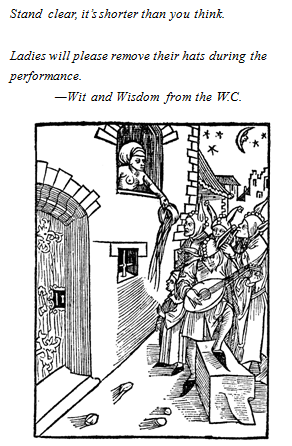It’s obviously time to ask for the facilities, the lavatory (or the abbreviated lav)—an old nineteenth-century word from the Latin lavatorium, “a place for washing.” Hoping to disguise your mission, you might request the place where you cough (c. 1920). Speaking more directly, the shithouse (19thC), the can (c. 1900), or the head. Why the head, when “tail” is more appropriate? It could be from the manner with which many relate to authority—a political statement of sorts. Or, as is more likely, from the location of the ship’s facilities—in the “bulkhead.”

When all is said and done, most Americans need room to do it. Today’s favorites include washrooms (c. 1878), bathrooms (c. 1850s), from a time when the necessary fixtures joined the bath, and powder-rooms. The little girl’s room (c. 1940s) is still with us today, though its counterpart, the little boy’s room, is seldom referred to. Dual-room names continue to dominate the landscape of restaurants nationwide: His ’n’ Hers, Gents and Ladies, Gulls and Buoys, Lads and Lassies, and Braves and Squaws (Ugh!).
Many prefer the restroom. But if you asked for it in England, your hosts would likely point out the cloak-room or show you to the bedroom. Perhaps you thought yourself couth by not asking for the toilet (c. 1820s–30s), or one of its mutant off-spring the toidy or toy-toy (20thC), but the toilet still works fine there among the working-class.The toilet derives from the French toilette, the diminutive of toile, the cloth once covering the table on which sat one’s preparations, making it all very acceptable.
Read more – http://bawdylanguage.com



Leave a Reply